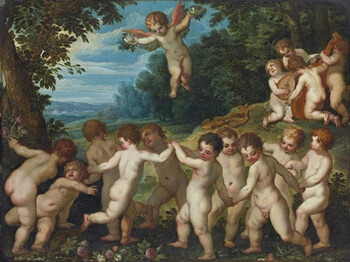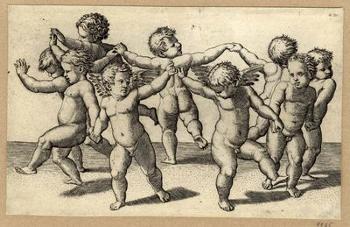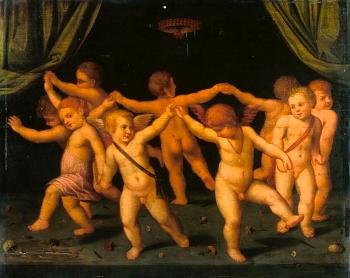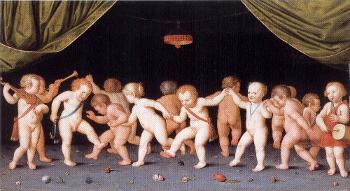6.800 €
The children’s dance
Oil on copper : 34,0 X 27,2 cm
Unsigned
Frame : 51,5 X 44,4 cm
In short
Our composition goes back to an iconic painting on copper by the German painter Hans Rottenhammer, painted circa 1600 in Venice, today at the Alte Pinakothek in Munich.
Rottenhammer was an important painter of so-called cabinet pieces: finely executed small copper paintings of mythological or biblical subjects. He started producing these works in Rome, together with the Flemish painters Paul Bril and Jan Brueghel the Elder. He only stayed there for one and a half year (1594/95), so he truly developed this new market in Venice in the succeeding 11 years (1595 – 1606).
Rottenhammer’s influence, especially on Flemish painters in Antwerp, was very important: for example on Hendrick van Balen I and on Frans Francken II.
About Hans Rottenhammer I
German painter
Munich 1564 – 1625 Augsburg
His first name is also spelt as Johannes.
Important painter of history (biblical and mythological) subjects and of genre scenes.
Pupil in Munich of Hans Donauer the Elder (1521 – 1596) between 1582 and 1588.
Rottenhammer was active in four different towns: Munich, Venice, Rome and Augsburg.
Rottenhammer travelled via either Tarvisio (in Austria) or Treviso (in Italy) to Venice, where he arrived in 1591. Here he fell immediately under the influence of the art of Titian, Veronese and Tintoretto (the only one of the three who was still alive).
During the spring of 1594 he travelled to Rome, where he stayed until the autumn of 1595. Here he discovered the drawing technique of Federico Zuccari and the sweet female figures of Raphael. And he started an important, separate collaboration with two Flemish painters: with Paul Bril (1554 – 1626) and with Jan Brueghel the Elder (1568 – 1625). Rottenhammer would paint the figures, the other artists the landscapes (and in the case of Brueghel the animals and flowers) on small copper plates. His collaboration with these two artists lasted well until his return to Germany. While Bril remained until his death in 1626 in Rome, Brueghel returned to Antwerp in 1596 (he died there in 1625); his collaboration with Rottenhammer seems to have lasted until 1610.
At the end of 1595 Rottenhammer returned to Venice. He married in 1596 a Venetian woman, Elisabetta di Fabris.
In Venice Rottenhammer worked with the new local star, Jacopo Palma the Younger (1548/50 – 1628), with the Flemish painter Hendrick van Balen the Elder (1575 – 1632) and with the German painter Adam Elsheimer (1578 – 1610). In the early 1600s Rottenhammer regularly worked (in Venice) for Emperor Rudolf II in Prague.
In Venice Rottenhammer had become a major painter of so-called cabinet pieces: finely executed small copper paintings of mythological or biblical subjects, holding many figures. These colourful paintings were very detailed, holding elegant, sensual (sometimes almost erotic) figures.
In fact he had re-arranged and transformed the grand Venetian painting onto small, easy to carry copper plates.His influence, especially on Flemish painters in Antwerp, was very important.
In 1606 Rottenhammer left with his wife (who only spoke Italian) and with his five children to Germany, to Augsburg. He remained here until his death in 1625. He painted from 1608 on a different, much larger scale: altarpieces for churches and decorative schemes with frescoes for palaces, such as for the Golden Chamber at Bückeburg Palace (near Hannover and Hamelin) and for the Residence of the Bavarian Duke Maximilian in Munich.
Sadly this great painter had a sad end to his life: due to his alcohol intoxication he lost all his belongings and ended his life in Augsburg’s almhouse.
About Raphael, Marcantonio Raimondi and Flemish Romanist painters
Several earlier compositions are known of dancing children, putti, cherubs or amoretti, painted by Flemish painters during the 2nd half of the 16th century. Most have been designed as “circle of Cornelis van Cleve”, some of these were in the past even attributed to Cornelis himself. Others have been called “circle of Otto van Veen” or “circle of Denys Calvaert”. Clearly scholars were looking into Flemish Romanist circles: Flemish painters who had travelled to or worked in Rome and Italy.
Two other names that appear with this particular composition are those of Raphael (1483 – 1520) and of his engraver Marcantonio Raimondi (1480 – 1534). There is indeed an engraving of dancing children known by Raimondi. This composition must indeed have triggered the idea for a round dance half a century later in Flanders.
Raimondi’s engravings are very interesting because in many instances he did not restrain himself to simply copying a finished painting by Raphael. Instead he seems regularly to have based his engravings on early sketches and drafts of the High Renaissance master.
Johann David Passavant (in his revision of the first modern comprehensive catalog of prints “Le Peintre-graveur” of Adam von Bartsch, 1860/64, vol. VI.27.167) mentioned a sketch by Raphael with a similar composition in the collection of Ploos van Amstel, Amsterdam, which is now apparently lost.
Loosely based on the Raimondi engraving paintings were made during the second half of the 16th century in Flanders on oak panels, but also in Italy on canvas (see for example the two paintings from the Galleria Sabauda in Turin).
Remains the question if Rottenhammer’s “Children’s dance” might have been influenced by the engraving of Raimundi or even by the lost composition of Raphael.
About our painting
Our painting goes back to a composition painted on copper (26 X 29,7 cm) circa 1600 in Venice by Rottenhammer. It is today at the Alte Pinakothek in Munich. It represents children making a round dance in a forest on the music of a lute and of a viola da gamba.
The animals, the tree at left and the flowers in the Munich painting were possibly painted by Jan Brueghel the Elder or by his workshop. But it is thought that this was done at a later stage (the painting had to be send to Antwerp), which would explain why two types of copies after this popular, innovative composition have been made: with and without the mentioned added elements. Ours is without, but it is very original as our painter changed the format into a vertical composition.
As to the meaning of such a children’s dance it remains a mystery: is it an allegory of the seasons or a cure against melancholy?
A small copper painting (270 X 20 cm) from the Royal Fine Arts Museum in Brussels represents Apollo and Ceres, plus four children dancing with Amor. The four children are holding different garlands of flowers, referring to the Four Seasons.
Italian Renaissance artist such as Donatello, Raphael and Mantegna had already represented dancing children earlier. Under the influence of Rottenhammer’s Munich composition Flemish painters of cabinet paintings, like Hendrick van Balen I and our painter also painted it. Van Balen’s pupil, Sir Anthony van Dyck, incorporated a children’s dance in his large canvas painting (215 X 285,5 cm) representing the Rest of the Holy Family on the Flight into Egypt, today at the Hermitage Museum in Saint Petersburg.
Why should you buy this painting?
Because this well executed painting on copper of a lovely composition testifies of the influence of Hans Rottenhammer on cabinet painters in Antwerp in the early 1600s.
Comparative paintings
Click photos for more details






